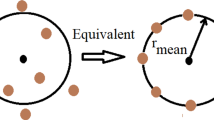Abstract
From the viewpoint of fracture mechanics, of importance is the near-tip field which can be characterized as field intensity factors. In this paper, the crack-tip field intensity factors of the stress and electric displacement in two dimensional piezoelectric solids are evaluated by using four approaches including the displacement extrapolation, the stress method, the J-integral and the modified crack closure integral method (MCCI) based on a boundary element method (BEM). The strongly singular displacement boundary integral equations (BIEs) are applied on the external boundary of the cracked solid, while the hypersingular traction BIEs are used on the crack faces. Three numerical examples are presented to show the path independence and the high accuracy of the J-integral in piezoelectric materials and to analyze the pros and cons of these approaches in evaluating the field intensity factors.








Similar content being viewed by others
References
Antunes FV, Ferreira JM, Byrne J (1999) Stress intensity factor calculation based on the work of external forces. Int J Fract 98:1–14
Blandford GE, Ingraffea AR, Liggett JA (1981) Two-dimensional stress intensity factor computations using the boundary element method. Int J Numer Methods Eng 17:387–404
Denda M, Araki Y, Yong YK (2004) Time-harmonic BEM for 2-D piezoelectricity applied to eigenvalue problems. Int J Solids Struct 41:7241–7265
Denda M, Marante ME (2004) Mixed mode BEM analysis of multiple curvilinear cracks in the general anisotropic solids by the crack tip singular element. Int J Solids Struct 41:1473–1489
Ding H, Chen WQ, Jiang AM (2004) Green’s functions and boundary element method for transversely isotropic piezoelectric materials. Eng Anal Bound Elem 28:975–987
Fedelinski P, Aliabadi MH (1996) Boundary element formulations for the dynamic analysis of cracked structures. Eng Anal Bound Elem 17:45–56
García-Sánchez F, Sáez A, Domínguez J (2005) Anisotropic and piezoelectric materials fracture analysis by BEM. Comput Struct 83:804–820
García-Sánchez F, Zhang Ch, Sládek J, Sládek V (2007) 2D transient dynamic crack analysis in piezoelectric solids by BEM. Comput Mater Sci 39:179–186
Lei J, Garcia-Sanchez F, Zhang Ch (2012) Transient response of an insulating crack near to the interface between two Piezoelectric half-planes under electromechanical impacts by BEM. Eng Anal Bound Elem 36:1205–1212
Lei J, Wang HY, Zhang Ch, Garcia-Sanchez F (2013) Crack-tip amplification and shielding by micro-cracks in piezoelectric solids-Part I: static case. Eng Anal Bound Elem 37:1585–1593
Maiti SK, Mukhopadhyay NK, Kakodkar A (1997) Boundary element method based computation of stress intensity factor by modified crack closure integral. Comput Mech 19:203–210
Martinez J, Dominguez J (1984) On the use of quarter-point boundary elements for stress intensity factor computations. Int J Numer Methods Eng 20:1941–1950
Mukhopadhyay NK, Maiti SK, Kakodkar A (2000) A review of SIF evaluation and modelling of singularities in BEM. Comput Mech 25:358–375
Nishioka T, Shen SP, Yu JH (2003) Dynamic J integral, separated dynamic J integral and component separation method for dynamic interfacial cracks in piezoelectric bimaterials. Int J Fract 122:101–130
Pan E (1999) A BEM analysis of fracture mechanics in 2D anisotropic piezoelectric solids. Eng Anal Bound Elem 23:67–76
Rajapakse RKND, Xu XL (2001) Boundary element modeling of cracks in piezoelectric solids. Eng Anal Bound Elem 25:771–781
Rao BN, Kuna M (2008) Interaction integrals for fracture analysis of functionally graded magnetoelectroelastic materials. Int J Fract 153:15–37
Sáez A, García-Sánchez F, Domínguez J (2006) Hypersingular BEM for dynamic fracture in 2-D piezoelectric solids. Comput Methods Appl Mech Eng 196:235–246
Suo Z, Kuo CM, Barnett DM, Willis JR (1992) Fracture mechanics for piezoelectric ceramics. J Mech Phys Solids 40:739–765
Wünsche M, García-Sánchez F, Sáez A, Zhang Ch (2010) A 2D time-domain collocation-Galerkin BEM for dynamic crack analysis in piezoelectric solids. Eng Anal Bound Elem 34:377–387
Acknowledgments
This work is supported by the Funding Project (No. 067135300100) for Academic Human Resources Development in Institutions of Higher Learning under the Jurisdiction of Beijing Municipality and the German Research Foundation (DFG) under the Project No. ZH 15/14-1, which are gratefully acknowledged.
Author information
Authors and Affiliations
Corresponding author
Rights and permissions
About this article
Cite this article
Lei, J., Wang, H., Zhang, C. et al. Comparison of several BEM-based approaches in evaluating crack-tip field intensity factors in piezoelectric materials. Int J Fract 189, 111–120 (2014). https://doi.org/10.1007/s10704-014-9964-2
Received:
Accepted:
Published:
Issue Date:
DOI: https://doi.org/10.1007/s10704-014-9964-2




